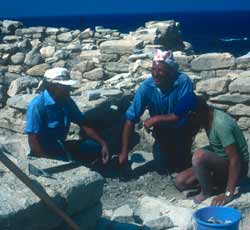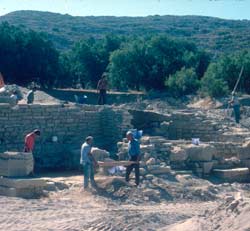Archaeology and survey on Crete
 Kommos Excavations: Minoan Hilltop Buildings, looking west. The three workmen are from the village of Pitsidia. © Lucia Nixon |
We saw earlier that archaeological work in Crete began in the later nineteenth century with Kalokairinos' trenches at Knossos and Halbherr's research on the inscribed Law Code at Gortyn, and that it gained tremendous momentum after the new Cretan government was established in 1898.
 Kommos Excavations: Building J. Looking east (1980). © Lucia Nixon |
Archaeological work has continued ever since then, but with interesting inconsistencies and unevenness in terms of space and time. There has been far more work done in central and eastern Crete; and despite much early interest in Graeco-Roman sites like Gortyn, there has been far more work on the Prehistoric period. Canadian excavations at Kommos in south-central Crete have uncovered houses and monumental buildings of the Minoan period, as well as temples of the Greek period.
In a way the chronological distortion is earlier to understand. Archaeological work began on Crete after excavations had begun on major mainland Graeco-Roman sites such as Corinth, Delphi and Athens. As we have already seen, the excitement surrounding the discovery of a prehistoric Aegean was intense: it was the Minoan Bronze Age which held the most promise for new sites and new interpretations.
 Kastelli, Khania, Greek-Swedish excavations. © Ministry of Culture Archaeological Receipts Fund |
The continuing spatial distortion and favour of central and eastern Crete is harder to understand. It does seem, though, that there were fewer large Prehistoric sites in western Crete. And though there are significant Minoan sites in the area of Rethymnon (Khamalevri and the cemetery at Armenoi), the largest Prehistoric site in the area of Khania is Khania itself: Minoan Kydonia is right under modern Khania.
Excavations within the city have brought to light tantalising fragments of important Minoan buildings, but for obvious reasons it will never be possible to excavate all of them.
Perhaps the most significant change in archaeological work on Crete, as elsewhere in Greece, has been the advent of archaeological survey (compare Unit 1 Session 5 Lesson 4). Most survey projects are diachronic - that is, they include at least two major chronological epochs (typically Prehistoric and Graeco-Roman); and most also collect environmental as well as archaeological information, in the manner of the earliest researchers on Crete such as Onorio Belli (who was introduced in Unit 2 Session 1 Lesson 1). And the spatial distribution of surveys has from the beginning been island-wide. Thus archaeological survey has helped to restore the breadth and depth of the best early work on Crete.